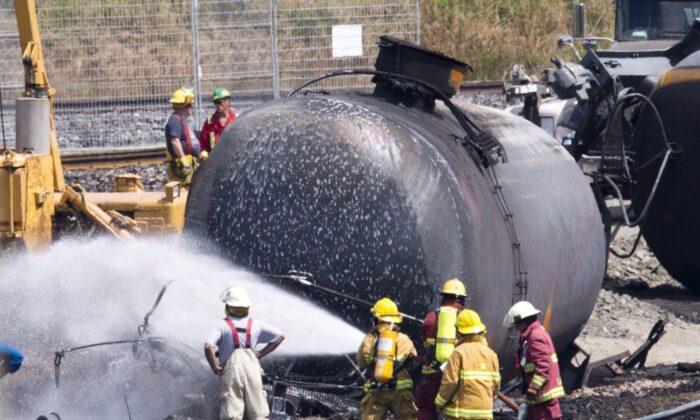LAC−MÉGANTIC, Que.—Raymond Savoie has lived all his 71 years in a small stone house, surrounded by farmland, that was originally built by his great−grandfather nearly 100 years ago in Lac−Mégantic, Que.
But last month, he and his partner, Rita Boulanger, learned that their home and part of their land will be expropriated by the federal government on Aug. 1 for a project to divert trains from the community’s downtown, parts of which were destroyed in 2013 when an oil−laden train derailed and killed 47 people.
At first he was told the house would be moved, or dismantled stone by stone and rebuilt, but he doesn’t believe them. “They want to put a bulldozer in it,” he said.
The 12.5−kilometre rail bypass was supposed to help the town heal from the collective trauma of the disaster. But 10 years after the tragedy, work has yet to begin, and the bypass has become a source of division and anger rather than unity.
Ottawa confirmed in mid−June that it would expropriate land from 43 residents, including Savoie, and said construction should begin in the fall. In response, lawyers representing some of the expropriated residents filed an injunction request in federal court last week, seeking to suspend the process until the case can be heard on its merits.
One of their lawyers, Frédéric Paré, says the federal government did not follow proper procedure and that seizing properties is premature because the Canadian Transportation Agency has yet to approve the construction of the bypass.
But the concerns of residents go beyond expropriations. At public consultations in May, some 63 parties and their lawyers raised objections to the bypass, according to the hearing officer’s report.
They lamented how the proposed bypass has more curves — which could trigger derailments — than does the current track. They also said surveys show the majority of residents in all three communities along the bypass route, including in Lac−Mégantic, oppose it. As well, they say alternate routes have not been properly studied and the rising price for the project has exploded.
But the most common concern was over the potential environmental impacts: loss wetlands, lowering of the water table, and spoiling of private wells.
A hydrogeology report published in May 2022 by the firm Englobe noted that several wetlands would likely be affected, either directly by construction or by lowering the water table. Wells, as well as surface bodies of water, such as rivers, could be impacted, it found.
Yolande Boulanger, 85, is supposed to lose nearly 36 acres of the farm where she’s lived since 1964.
Boulanger, who lost her 19−year−old grandson in the Mégantic rail tragedy, says her opposition to the bypass isn’t just about losing part of the cattle farm that has been owned by her late husband’s family since 1933, or feeling the vibration from the trains that will pass in front of her barn. Instead, she said she’s fighting for the town’s water, which she’s convinced will become contaminated by the blasting and digging to come.
“If this (bypass) happens, it’s another catastrophe in the making,” she said.
Paré, meanwhile, said the route was chosen “based on the costs of 2017 and especially the expertise we had in 2017.”
“At that time, there was no question of wetlands, there was no question of a bridge, there was no question of digging a canyon,” Paré said. “The project has changed a great deal.” He said most of the environmental assessments were carried out before construction details were known and that the amount of land being expropriated has also risen significantly.
Paré said the proposed route was chosen partly because it was cheaper — an estimated $133 million when Prime Minister Justin Trudeau and then−Quebec premier Philippe Couillard announced joint funding in 2018. Transport Canada won’t confirm, but Paré said opponents believe it will now cost close to a billion dollars for what amounts to a “gift” to a private rail company.
Transport Canada says it remains fully committed to the bypass, which will reduce the number of residences located close to the track from 265 to eight, and reduce level crossings from 16 to four.
However, despite the commitments, the final project still hasn’t been approved.
On Wednesday, a spokesperson for the Canadian Transportation Agency suggested the application from Central Maine and Quebec Railway Canada is incomplete. The agency issued a letter in February to the company requesting more information, including on how the findings of a recent hydrogeology study were incorporated into an evaluation of the project’s environmental impact.
Canadian Pacific Kansas City, which owns the railway in Lac−Mégantic, said in an email that the transportation agency’s request required “significant additional work” from both the company and Transport Canada, and that it was working “diligently” to complete its portion.
Lac−Mégantic Mayor Julie Morin has said the bypass is needed due to the sloping topography of Lac−Mégantic, the “collective trauma” of the derailment, and the increasing number of railcars carrying hazardous materials through the heart of downtown.
Transport Canada did not confirm the price of the bypass, but said the federal and provincial governments had agreed to increase funding to cover the rising costs.
For now, Savoie and Boulanger say they have no intention of packing their bags. They’ll stay in the little stone house, where Boulanger grows vegetables in raised beds made from antique farm machinery, and where Savoie harvests the hay to feed their three cows.
They say they still don’t know how much compensation they’ll receive, and that the stress and uncertainty has meant they both now need to take medication to sleep. But they say they’ll fight on until the end, hoping Savoie can finish his days in the home where he was born.





